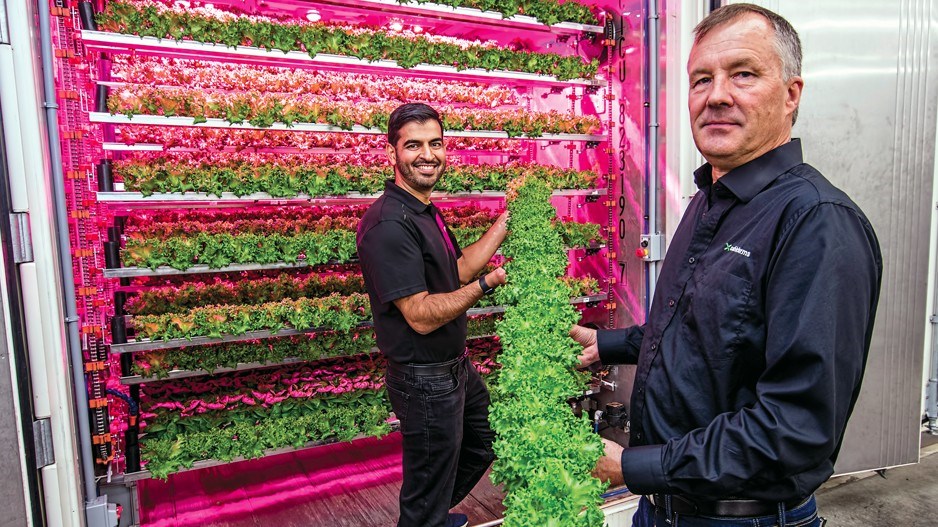With wildfires and a heat dome battering B.C. for much of the summer, Michael Gilbert spent time with investors discussing the potential for big data to help farmers get ahead of bad conditions for growing crops.
The summer eventually concluded with downpours on the West Coast and investor capital to the tune of $100 million gushing in for Vancouver’s SemiosBio Technologies Inc. late last month.
“What we’ve learned through this pandemic is that we’re already maxed out, and we really cannot afford for our food system to fail for a whole season – that’s just not on the table anymore,” said Semios CEO and founder Gilbert, whose company is best known for using sensors and data to ensure healthy crops for farmers by monitoring for harmful weather and pests. The B.C. firm has about two million sensors deployed around the globe to monitor the health of crops.
The outset of the pandemic brought on disruptions to supply chains, while climate change is rattling agricultural lands and a global fertilizer shortage is raising uncertainty over food security. Demand has consequently grown for made-in-B.C. technology addressing concerns over reliable access to food.
Last month, CubicFarms Systems Corp. (TSX:CUB) received an order from a private investor group for an indoor growing system covering one acre of land within Greater Vancouver.
The system, featuring 96 double-stacked modules that look like shipping containers, will be able to produce the equivalent of 100 acres’ worth of salad products grown in a field. Another 24-module system offering a controlled environment for growing crops was also sold recently to customers in Calgary.
Indoor growing allows for crops to be grown 12 months a year, while cultivation is less labour-intensive than sending workers outdoors to face the heat, cold or rain. A 2019 Royal Bank of Canada (TSX:RY) report estimates that the country’s agricultural labour shortage will grow to 123,000 positions by 2030.
“Farm labour has become such an acute issue that many farmers are having to leave crops in the field,” said CubicFarms CEO Dave Dinesen, whose company also produces separate modules for growing livestock feed (the global fertilizer shortage also threatens to reduce access to animal feed and in turn inflate meat prices).
“And so we need technology to be able to eliminate the requirement for so much labour.”
He said the company’s flagship modules, which feature rotating trays that bring crops to workers who stand in front, might have been considered a “nice-to-have” technology not too long ago.
“Before, growing locally was a little more romantic and nice. I think now it’s absolutely necessary, and that’s the change that’s happened in the last few years because of supply chain/food security issues [and] climate change only increasing at an exponential rate,” Dinesen said. “Climate change is making it harder and harder for farmers to grow reliably.”
This past spring, Vancouver-based Terramera Inc. set about launching a first-of-its-kind Canadian market for carbon sequestration using technology that can better quantify carbon within farm soil without the reliance on expensive labour and lab work currently needed.
In the U.S., the market leans heavily on best estimates based on initiatives deployed by farmers, such as the growth of cover crops or soil-tilling practices.
But if buyers of carbon credits are confident about the (potentially much less expensive) quantifications of carbon within the soil, Terramera CEO Karn Manhas sees the market for such credits opening up in Canada.
“Our focus is to drive down the cost of quantification towards $5 per acre, which really opens up the market and also enables Canada to establish a standard for consistent soil carbon quantification across the country, one that we can test alongside the traditional expensive ways to show that it’s just as accurate,” he told BIV in May.
“Not only do they [farmers] get paid for the carbon they sequester, but it also improves their productivity in the medium and long term.”
Terramera spokeswoman Kim Haakstad told BIV this month that the healthier soil created through this sequestration process also means higher-quality crops and more predictable outcomes when harvesting. Farmers, she said, can also expect to be paid more for the higher-quality crops.
Gilbert, meanwhile, said data will be key to ensuring food security in the long term.
“We collect data to understand what is the risk and then we automate the control systems to mitigate that risk,” said Gilbert.
“And when you’re doing that at scale with big data, you’re able to really focus in on what are the key risks and manage them more effectively instead of a spray-and-pray approach where you just keep on pushing more water and more chemicals in the field.” •




